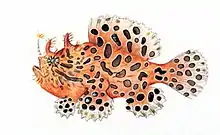Cleithrum
The cleithrum is a membrane bone which first appears as part of the skeleton in primitive bony fish, where it runs vertically along the scapula.[1] Its name is derived from Greek κλειθρον = "key (lock)", by analogy with "clavicle" from Latin clavicula = "little key".
In modern fishes, the cleithrum is a large bone that extends upwards from the base of the pectoral fin and anchors to the cranium above the gills, forming the posterior edge of the gill chamber.[2] The bone has scientific use as a means to determine the age of fishes.
The lobe-finned fishes share this arrangement. In the earliest amphibians however, the cleithrum/clavicle complex came free of the skull roof, allowing for a movable neck. The cleithrum disappeared early in the evolution of reptiles, and in amniotes is very small or absent.
See also
References
- Romer, Alfred Sherwood; Parsons, Thomas S. (1977). The Vertebrate Body. Philadelphia, PA: Holt-Saunders International. pp. 184–186. ISBN 0-03-910284-X.
- "Fish Glossary". University of Wisconsin Sea Grant Institute. 5 February 2002. Archived from the original on 2011-03-13.
.png.webp)
